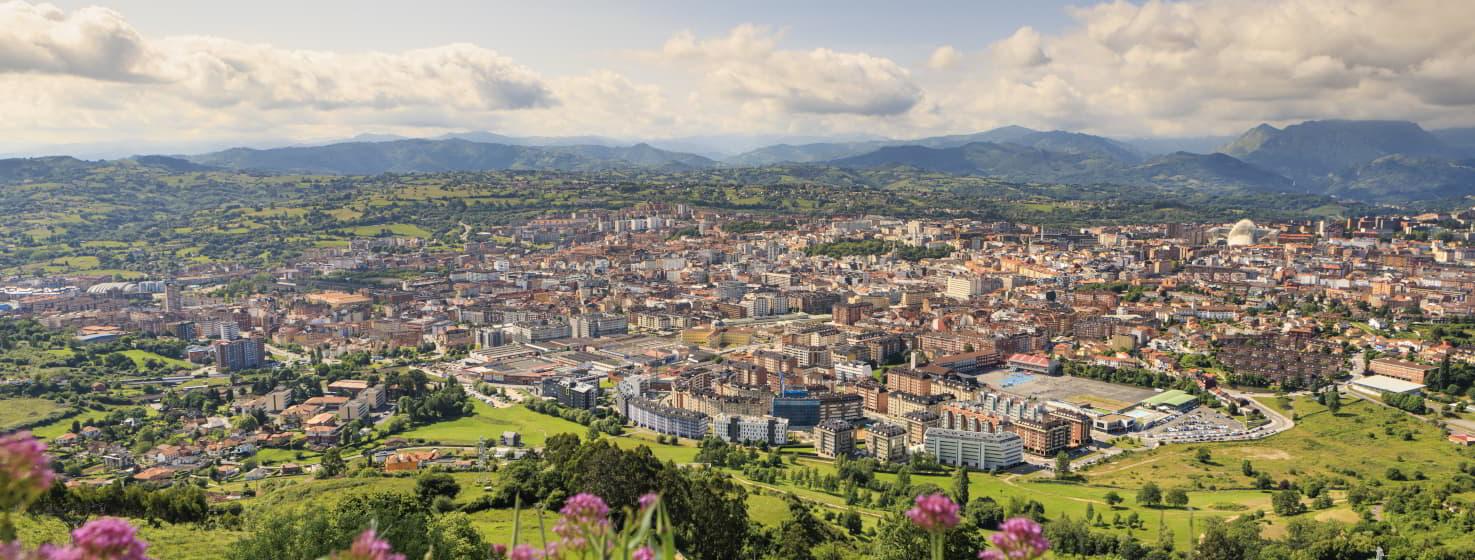
Oviedo

Oviedo/Uviéu is the triple capital: of its council, of the whole of Asturias and of pre-Romanesque art. It is a city that, far from being a tourist exhibitionist, shows itself as it is on all occasions. Its great sense of urbanity means that every detail - from the cleanliness of the streets to the slow rhythm of the traffic lights - is a declaration of intentions. It has also managed to combine the urban with the rural like few other places. Its large belt of parks, greenways and parishes invites you to lose yourself in nature and to breathe. Not forgetting its firm commitment to culture, which reaches its peak every autumn, when Oviedo hosts the Princess of Asturias Awards(opens in a new tab). A tribute to talent, knowledge and human commitment that finds in this city an unforgettable setting.
The Capital of Asturias
Oviedo/Uviéu is not only the capital of (all of) Asturias: it is Asturias concentrated, decanted, refined... The stones of its pre-Romanesque monuments came out of its best quarries, its gastronomy is nourished with the flavours of all Asturias, and in every corner there is a piece of pomarada, whether in the form of a bottle of cider or a traditional cider house. Folk dances coexist with dance; bagpipes and drums with chamber music, and tonada with opera.
Every May, the Ascension Fair transforms the town into a great rural showcase. Cattle are exhibited, cheese and agri-food products are tasted, and you can hear people speak loudly in all variants of Asturian. Also in spring, the Martes de Campo (Country Tuesday) turns Oviedo/Uviéu into a great pilgrimage. The parks become the "prau", and the whole city sits on the "yerba" to eat the "bollu preñau". At the beginning of June, the Preba de la Sidra (Cider Festival) consecrates it as an emotional capital, with half of Asturias pouring and tasting the first cider of the season in Gascona Street.
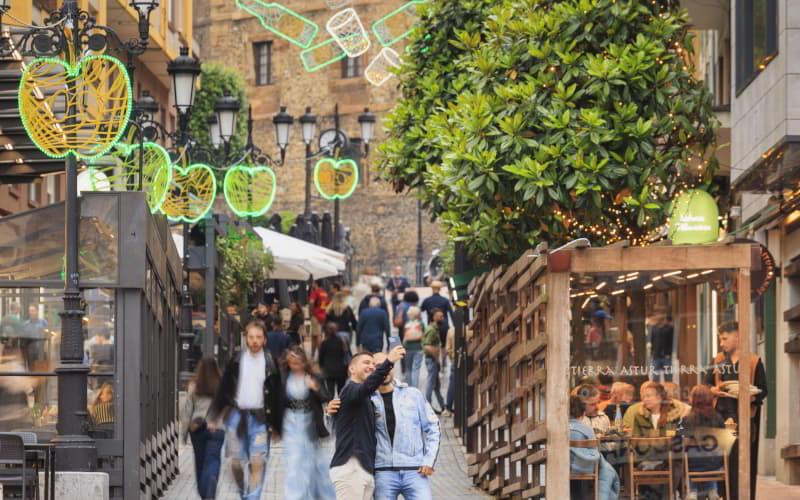
Oviedo/Uviéu likes to boast about its Asturianness - although it does not need to assert itself or boast about its capital status. Its people proudly bear the nickname of "carbayones", in memory of that great oak tree (carbayón), with more than 500 years of history, which presided over the city. And if Asturias resembles anything - strong, healthy and with deep roots - it is, precisely, a carbayu.
History and culture of Oviedo
The history of the city began with Alfonso II the Chaste, who elevated it to the court of the Asturian kingdom and made it shine with its own light with its pre-Romanesque constructions, today a World Heritage Site: Santa María del Naranco, San Miguel de Lillo, San Julián de los Prados or the fountain of La Foncalada.
The Cathedral of San Salvador, known as Sancta Ovetensis, began to be built at the end of the 13th century on the remains of the foundational basilica. Its Holy Chamber, the largest reliquary in Christianity at the time, still houses the Holy Shroud, the Victoria Cross carried by Pelayo in Covadonga, and other symbols that made Oviedo/Uviéu an obligatory stop for medieval pilgrims taking the Camino de El Salvador from León. The cathedral is also today, as in the times of Alfonso II, the starting point of the Primitive Way to Santiago.
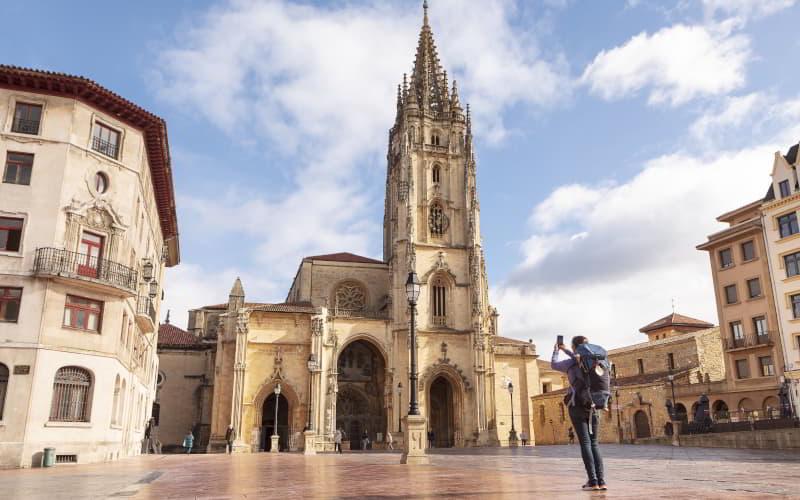
But its Gothic tower not only looks up to the sky, it also shadows the Vetusta described in La Regenta, that portrait of the city drawn by Clarín with surgical precision. We can join a guided tour(opens in a new tab) that takes us to the top of this tower and, after climbing its almost 200 steps, we can enjoy a magnificent 360-degree view of the city. At the bottom, the statue of Ana Ozores silently watches over the cathedral square, the ideal starting point for another themed walk around the sculptures that populate the city. Immobile figures that sit on benches, surprise us as we turn the corner or guard squares with the aplomb of the passage of time and their own tonnage. Some are rotund, almost monumental; others, more discreet but full of meaning, prolong the spirit of the Princess of Asturias Awards. Every autumn, the Campoamor Theatre becomes a cultural beacon of the civilised world (that which thinks, writes, composes, researches or puts its life on the line for others), and the genius of the laureates tends to remain, in some way, in the capital of Asturias.

It is therefore not surprising to find Mafalda sitting on a bench in Campo San Francisco, with that lucid gesture of hers in homage to her creator Quino - awarded in 2014 -. We also come across Woody Allen himself, eternally absent-minded, strolling around like just another "carbayón", without giving himself any importance despite having been awarded the Princess of Asturias Award for the Arts in 2002.
Another heart of the city is the University of Oviedo, whose historic building is not far from the cathedral. As is the Archaeological Museum of Asturias, one of the most recommendable cultural centres in the whole Principality, the most modern and up-to-date in Spanish archaeology. With almost 5,000 square metres of surface area, and hundreds of pieces and remains of great value, ranging from prehistoric times to the Asturian Middle Ages.

Without leaving the old town, the Museum of Fine Arts of Asturias is well worth a leisurely visit. Spread and communicated between several historic buildings, it has been able to bring together one of the great collections of our country, with works by El Greco, Goya, Sorolla, Picasso, Tàpies, or the Asturians Evaristo Valle and Nicanor Piñole. The Philharmonic Theatre and the Príncipe Felipe Auditorium add music, cinema and drama to the city, while Calatrava's futuristic building, with its architectural counterpoint, serves as a conference centre.

Nature and outdoor activities in Oviedo
Oviedo/Uviéu is not only a city, it is also a council with a lot of rural and scenic substance. Beyond its central parks - such as San Francisco or El Campillín -, the first natural horizon is perhaps established by Monte Naranco, to the north of the city. A promontory that exceeds 600 metres in altitude and can be reached on foot in just over an hour - although less epic, it can also be climbed by car. The ascent, frequented by hikers and cyclists, crosses unique landscapes that hold the most valuable heritage of this land: the monuments of Santa María del Naranco and San Miguel de Lillo.
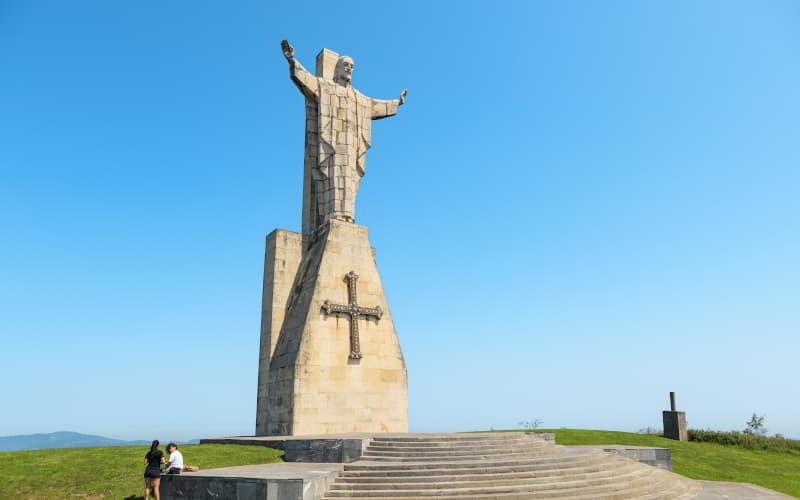
From the top of the hill, under the colossal shadow of the Sacred Heart, Oviedo/Uviéu is whole, clear and recognisable; a clear view that invites you to stop, trace its contours with your finger and look for its most important landmarks. All around us, more than 30,000 square metres of nature in its purest state, including sports tracks and recreational areas.
At the foot of Naranco, near the neighbourhood of La Florida, lies the Purificación Tomás Park, one of the largest in the council. It occupies an old estate over a pre-Roman castro, with privileged views of the Naranco and the Sierra del Aramo. It has everything: children's areas, picnic areas and sports courts.
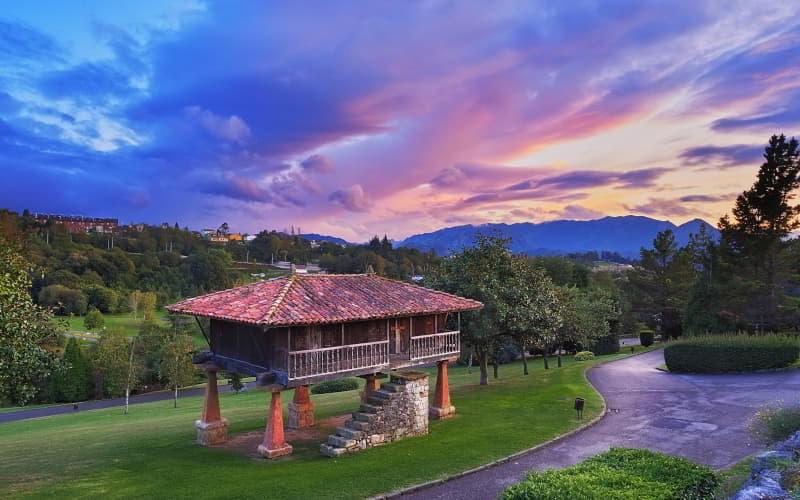
To the south of the city, the Winter Park is the starting point for another essential route: the Fuso Greenway, which follows the old mining railway line between tunnels, trees and old stations, until it reaches the nineteenth-century spa of Las Caldas, one of the most important thermal centres in the Cantabrian Sea today. In this same town is the Municipal Golf Course and a river path, some 6 kilometres long, parallel to the river Nalón. From the Winter Park we can also head towards La Zoreda, a unique forest which is home to the largest forest reserve in the council. In addition, among the oak trees and paths are hidden the remains of its industrial and military past: bunkers, powder magazines and old furnaces.
And if you can't get enough of Oviedo's nature, you can join guided tours of its industrial heritage(opens in a new tab), such as the one that shows you the La Vega Arms Factory, a unique monumental complex in Spain and a symbol of the industrial era; or the Royal Munitions Factory in Trubia, a pioneering town in the industrialisation of Asturias. It is also possible to visit the surroundings of the old San Claudio Earthenware Factory, which for a whole century filled the homes of half of Spain with hard-wearing and charming crockery. In Faro, in the parish of Limanes, its potters have been supplying pots and jugs to Asturians since the 19th century. Today, the family tradition still survives, transforming the clay into unique pieces: plates, bowls, figures, borders and coverings.

In the municipal limits of Oviedo/Uviéu we can also connect with cycling adventures for the whole family, such as the Senda del Oso in the neighbouring council of Proaza; or take on real cycling challenges, such as the mythical Angliru, which starts in the neighbouring council of Riosa.
Tips for enjoying Oviedo
Its lively cultural life, its university atmosphere, its tasty cuisine and its excellent location, less than 45 minutes from the airport and with a high-speed train connection, make Oviedo/Uviéu an irresistible destination. Ideal times to visit are spring and autumn. It is neither hot nor cold, and the city offers its best light and the most genuine atmosphere.
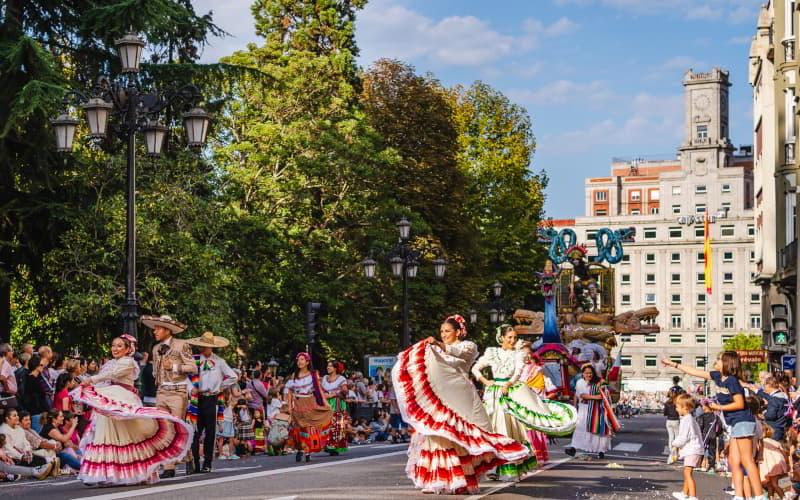
But if there is a specific date that is perfect for a visit to the Asturian capital, it is undoubtedly the second half of September, coinciding with the San Mateo festivities. The festivities usually last more than a week, with dozens of free concerts, activities for all ages and streets full of life. One highlight, for example, is America Day in Asturias (19 September), a unique parade commemorating the link between the region and its American diaspora. Creole-inspired floats, gala costumes, mariachis, Andean dances and Asturian bagpipes coexist in a show that is an emotional mestizaje and a heartfelt tribute to the Indiano who took Asturias to the other side of the Atlantic. Its originality and animation have made this very special day a Festival of Tourist Interest in Asturias.
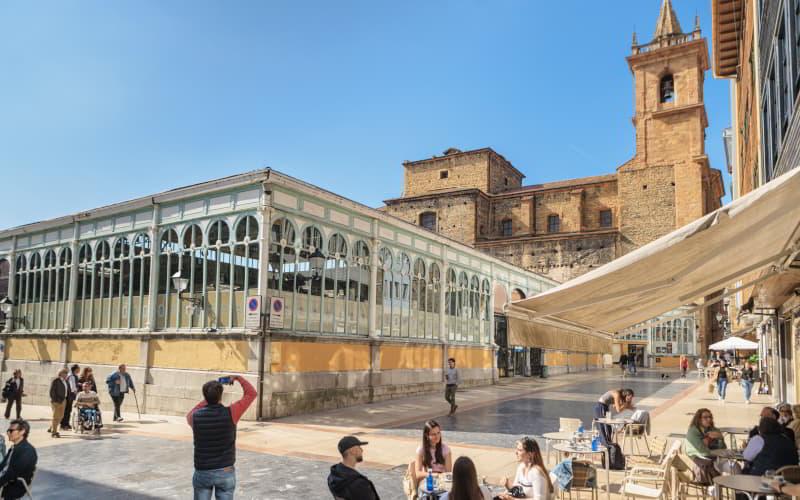
For accommodation we can imitate the winners of the Princess of Asturias Awards, and stay at the distinguished Hotel de La Reconquista, although many other modern accommodations in the capital are not far behind in comfort and services, including urban flats adapted to our contemporary tastes and needs, or a good number of charming and well-equipped rural houses in the outskirts of the city. The first thing to do after leaving your suitcases is to take a leisurely stroll through the old town and its urban expansion.
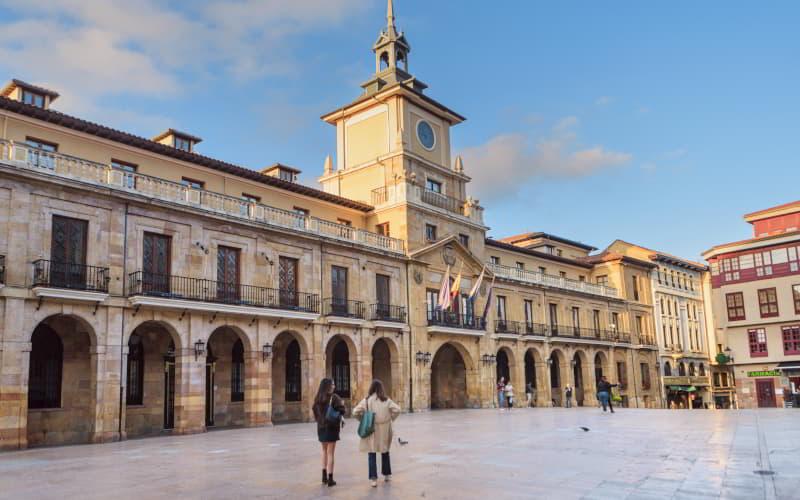
In the monumental centre near the cathedral there are many charming squares such as the Town Hall, Porlier or the Fontán, with its covered market. The promenade runs between arcades, sculptures and cafés steeped in history. The Plaza de la Escandalera and the streets Cimadevilla, San Francisco, Fruela or Uría mark the city's civic and commercial pulse, while the Campo San Francisco (90,000 m²) acts as a green lung, an everyday space, large but welcoming, where families, readers and the curious stroll among lime trees, beeches and horse chestnut trees. The ruins of the old Franciscan monastery and illustrious neighbours such as squirrels, ducks and peacocks coexist here. It is increasingly frequented by those who are looking for the mythical Mafalda's bench, as if it were the test of a treasure hunt.

And if you are looking to eat and drink cider, you should go to the aforementioned Calle Gascona, known as the Bulevar de la Sidra, one of the city's gastronomic hubs. Nearby is the Gran Bulevar El Vasco, and the whole of the historic quarter where you can eat well. For tapas, there is nothing like the popular Wine Routes: one runs along the streets Campoamor, Manuel Pedregal and Río San Pedro; the other winds its way around Avenida de Galicia and Plaza de América, where there is no shortage of excellent à la carte options. In fact, in the whole town centre, in every self-respecting neighbourhood, and in all the towns and villages of this municipality, food is always a long way ahead.

A large network of restaurants and cider houses distil the best of regional cuisine with skill. Oviedo/Uviéu is the place where Asturian gastronomy becomes haute cuisine while remaining popular. The raw material is treated with the same devotion as the service at the table. The fabada does not allow shortcuts, the fish is presented with all its nobility, the cachopo is well-stocked and generous, the cheeses are better the more "refined" they are, the rice pudding is always "requemao" and as for the cider... well, you have to work hard to serve it, if possible to the point of perfection. The city also enriches the regional cuisine with its own specialities, such as chickpeas with cod and spinach, or the Oviedo tripe with which it commemorates the Gastronomic Festival of Desarme, declared to be of Tourist Interest in Asturias. Special mention should also be made of the carne gobernada, which is a trademark of the house, as well as the local confectionery, with carbayones and moscovitas at the top of the list.
Oviedo/Uviéu stays in your memory like those books that you don't lend to anyone because you always plan to return to them. It is a cultural experience in the broadest sense. It is not worth visiting with a tourist mentality. More than "seeing a lot", here it is about putting all your senses into every moment.
Images
Map
What to see
- Top ten things to see and do in Oviedo
- Cathedral, Holy Chamber and Old Town.
- Holy Shroud.
- Campoamor Theatre and Princess of Asturias Awards.
- Pre-Romanesque monuments and Monte Naranco.
- El Fontán Market, Museums: Archaeological and Fine Arts.
- Rural Oviedo (Limanes, Lighthouse, etc.).




